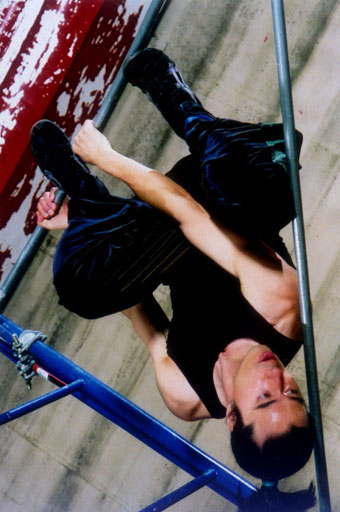
|
|||||
|
|
Dance troupe mimics primates moves by Christina L. Barber - staff writer |
||||
|
NORTHAMPTON Perhaps you remember Harry Harlow from Psych lO1. His classic research revealed that infant monkeys raised with a mother's love and warmth - Harlow called it "contact comfort" - were happy and normal, while newborns raised by monkeys made of wire, which provided food and milk but no contact comfort, were emotionally deprived and distressed Saliq Francis Savage says he never forgot the essential lesson of Harlow's research--that love and contact are even more important than actual nourishment. "It has been very important in my existence," he says. This weekend, the South Hadley based teacher, dancer and choreographer will pay homage to this lesson with a collaborative dance called "Wire Monkey," which he conceived with Harlow in mind. "Wire Monkey" will consist of Savage and six other dancers hanging, swinging, leaping and flying through a V-shaped maze of blue steel scaffolding and wooden planks. The hulking structure, set up at the Northampton Center for the Arts, is 30 feet long, 18 feet high and up to 18 feet wide. The structure rotates on wheels, transforming from human prison to primate playground and back again. As such, it highlights the disconnect between our origins and our evolution. "Wire Monkey" is a metaphorical rumination on contact comfort, Savage says. "We're all struggling to find our connection, to be a tribe, to be related," he says. "How do we find our people? Who are our people?" Savage hopes the dance will answer some of these question by encouraging audience members to "remember that we're all connected, we're all primates." As "Wire Monkey" is an improvisational piece rather than a set work, Savage says, "there's the possibility for magic to happen." In order to make the scaffolding come alive, the dancers--four women and three men--must, like monkeys, tap into their most reflexive and primal instincts. That's no easy task, even for experienced dancers. "It's totally different in terms of the structure and the kind of movement that it requires," says troupe-member Catherine Musinsky of Somerville. Working with scaffolding takes a great deal of arm strength and acrobatic prowess -- not to mention a certain degree of fearlessness. "There's a lot of danger involved," Musinsky says, noting the structure's daunting height. But months of rehearsals have blunted the troupe's collective anxiety. These days, Musinsky says, moving, around the scaffolding feels "more like walking down a sidewalk than climbing a ladder." (Savage has liability insurance just in case.) Early this year, Savage held auditions for "Wire Monkey" in Montreal, Boston and Northampton, culling a few dancers from each locale. The seven-member troupe began rehearsing in April, spending a few months just exploring how to move on the structure, which at one point was set up in the woods, presumably so the dancers could get in touch with their inner primate. In forming the troupe, Savage says he sought dancers with "bodies that were connected, that had a resiliency and an innate understanding of their physicality - dancers much like himself. Savage grew up in the suburbs of Milwaukee, where his father dared him to clamber up trees. Avid tree-climbing prompted Savage's life-long desire to explore what he calls "the boundaries of physical mastery." He studied dance, movement analysis and movement therapy, subsequently becoming a certified practitioner and teacher of Body-Mind Centering, or BMC. Today, he teaches at the School for Body-Mind Centering in Amherst, where he specializes in contact improvisation. "I teach people how to touch," he says, invoking Harry Harlow. Savage has also created performance pieces in North and South America and Europe, but "Wire Monkey" is his most ambitious project ever, he says. A humble yard sale sparked the piece into being. A contracting company was selling off its supplies, including a bunch of scaffolding, which Savage bought on a whim. "The conception of the idea came with that purchase," he says. He amassed more and more scaffolding until the structure, which he built on a trial-and-error basis felt complete. "Wire Monkey" isn't the first dance performance to take place on something other than a flat stage. De LaGuarda is a flying circus-like fusion of theater, dance, music and performance art in New York City, and the dancer-illusionists of the MOMIX company have used scaffolding in their pieces. But Savage says the extent to which he's using the stuff is unprecedented. Still, "Wire Monkey" will have a few things in common with De La Guarda: It will meld dance with live music and video, and the audience will be encouraged to stand and view the hour-long work from different vantage points as the steel structure rotates around the room, expanding and contracting like an amoebae. This weekend's production is "the manifestation of a big dream into reality," Savage says. "Hopefully it will ignite something and keep something going." |
|||||

